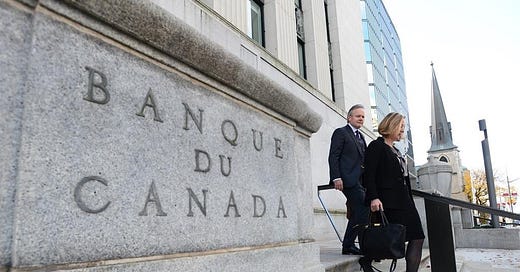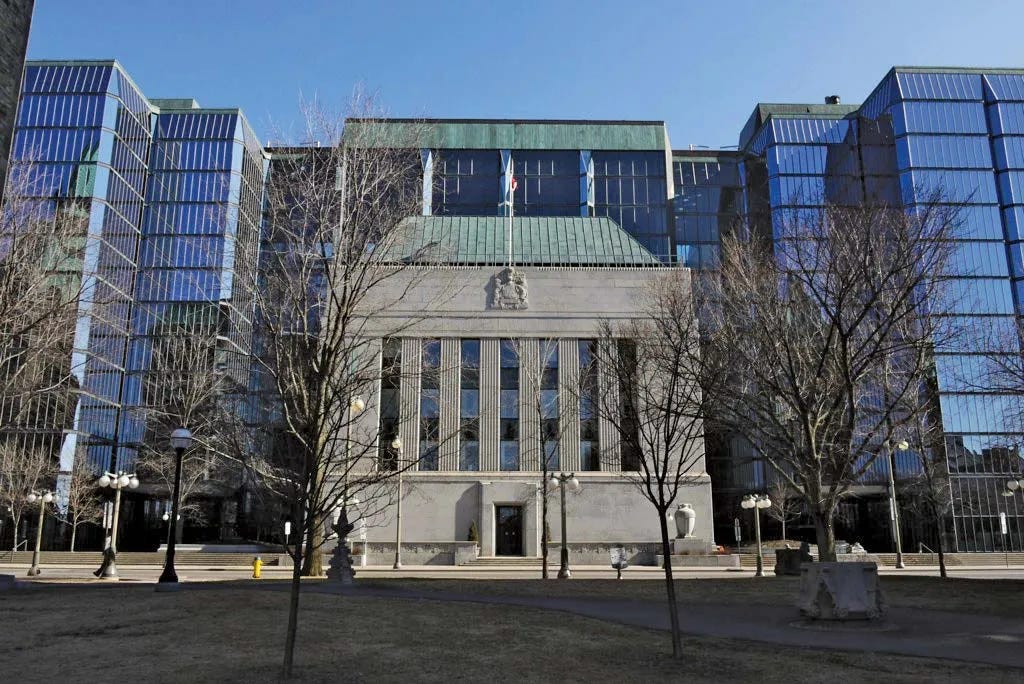Are Interest Rates the Right Tool for the Job?
Less affordable housing; fewer jobs; lower pay; less investment in technology, infrastructure, innovation, and the future; and still no meaningful saving accounts. Welcome to Demand-Side Economics
Demand-side economic policies focus on changing the demand for goods and services in an economy. By adjusting interest rates, central banks can influence the amount of money circulating in the economy, thereby affecting consumption and investment levels.
When central banks lower interest rates, borrowing becomes cheaper. This can encourage businesses to invest and individuals to spend or take on more debt, increasing the overall demand in the economy. Conversely, when central banks raise interest rates, borrowing becomes more expensive, which can discourage investment and spending, decreasing the demand in the economy.
In Canada, the Bank of Canada, which is the country's central bank, uses interest rates as a tool to manage monetary policy with the primary goal of controlling inflation. The key interest rate that the Bank of Canada controls is the overnight rate. This rate influences other interest rates, such as those for consumer loans and mortgages, which in turn affect spending habits of consumers and businesses. When the Bank of Canada increases the overnight rate, borrowing becomes more expensive, which typically cools economic activity and helps to control inflation. Conversely, when the Bank of Canada decreases the overnight rate, borrowing becomes less expensive, which can stimulate economic activity but can also lead to inflation if the economy is near its capacity. Changes in interest rates can also influence the exchange rate of the Canadian dollar, which can have additional effects on the economy. The Bank of Canada typically reviews its interest rate policies eight times a year in what are known as "fixed announcement dates."
While using interest rates is a widely-accepted method for controlling inflation, it does have several potential limitations and weaknesses:
Time Lags: Monetary policy, including interest rate changes, often has a significant lag before it starts impacting the economy. It can take time for changes in interest rates to permeate the economy, affect spending and investment decisions, and eventually impact inflation.
Incomplete Control over Rates: While central banks can directly influence short-term interest rates, long-term interest rates are determined by market forces. Sometimes, these long-term rates, which affect investments and long-term loans (like mortgages), might not move in the expected direction, diminishing the effectiveness of interest rate policy.
Negative Impact on Debtors: Higher interest rates can lead to increased debt service costs for both individuals and businesses, potentially leading to financial stress or defaults.
Inequality: Higher interest rates can be advantageous for people who have savings and assets, while they can be disadvantageous for people who have debts, potentially exacerbating economic inequality.
Global Factors: In an increasingly globalized world, domestic interest rate policy might be influenced by global financial conditions and the policies of other central banks.
Lower Bound: The ability to stimulate the economy through lowering interest rates has a limit, as interest rates cannot effectively go below zero. This is often referred to as the "zero lower bound" problem. While some central banks have experimented with negative interest rates, it is still a controversial and unproven method.
Asset Bubbles: Lower interest rates can sometimes lead to asset bubbles if the cheap credit fuels speculative investment in assets like housing or stocks.
Exchange Rate Effects: Changes in interest rates can lead to changes in exchange rates, which can have complex effects on the economy. For example, higher interest rates might strengthen the currency, which could hurt exporters.
Inflation Expectations: If a central bank doesn't manage interest rates effectively and allows inflation to rise, it could lead to increased inflation expectations, which can be self-fulfilling and difficult to control.
Limitations in Influencing Demand: Interest rates primarily influence the demand side of the economy. However, in some situations, such as a supply-side shock or a pandemic, demand-side tools might not be as effective.
Economic growth and inflation are complex phenomena with multiple underlying causes. The factors contributing to each can sometimes overlap, but they are distinct concepts.
I. Economic Growth: Economic growth refers to an increase in the production of goods and services over a specific period. This growth is generally measured in real terms, meaning it accounts for inflation.
Technological Innovation: The development of new technologies can lead to improvements in productivity and efficiency, driving economic growth.
Human Capital: The skills, knowledge, and experience of the workforce can greatly contribute to economic growth. Investments in education and training can increase human capital.
Physical Capital: The amount of physical resources, such as machinery and infrastructure, available can contribute to economic growth.
Natural Resources: The availability and exploitation of natural resources can provide an initial source of growth.
Capital Accumulation: Investments in new capital goods can increase productivity, leading to economic growth.
Political Stability and Good Governance: A stable political environment with good governance practices can promote investment and economic growth.
Trade Policies: Open trade policies can allow for specialization, increased competition, and access to larger markets, contributing to economic growth.
Institutional Quality: The quality of institutions, including property rights, rule of law, and transparency, can affect economic growth.
Population Growth: Population growth can contribute to economic growth by increasing the size of the labor force.
Health of the Population: A healthier population can be more productive, which contributes to economic growth.
II. Inflation: Inflation refers to the rate at which the general level of prices for goods and services is rising and subsequently, purchasing power is falling.
Demand-Pull Inflation: This occurs when demand for goods and services exceeds their supply.
Cost-Push Inflation: This happens when costs of production increase, causing producers to raise prices to maintain their profit margins.
Built-In Inflation: This is inflation that is expected to occur, often as a result of past inflation.
Monetary Policy: Central banks can influence inflation through their control of the money supply. Increasing the money supply can lead to inflation.
Exchange Rates: Changes in exchange rates can affect the price of imports and exports, influencing inflation.
Government Spending: Increased government spending, especially if it's financed by printing money, can lead to inflation.
Global Conditions: In a globalized economy, inflation can be imported from abroad – for example, if there is inflation in the countries that supply key commodities.
Wage-Price Spiral: This refers to a situation where wages and prices chase each other upwards. As prices rise, workers demand higher wages, which then leads employers to raise prices to cover the increased wage costs.
Expectations of Inflation: If businesses and individuals expect prices to rise in the future, they might increase prices and wages, leading to inflation.
Supply Shocks: Events that unexpectedly change the supply of goods, like natural disasters or oil shocks, can lead to temporary increases in prices and inflation.
So, let’s review. Which of these things are most responsible for the current inflation and unexpectedly strong growth trend in Canada? Given the answer, is Demand-Side interest rate hiking the right tool for the job?
Nope.






